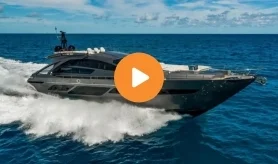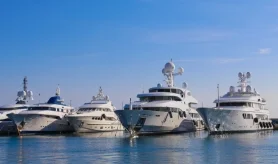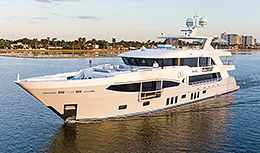- Alaskan Yachts
- Azimut Yachts
- Back Cove Yachts
- Beneteau Yachts
- Benetti Superyachts
- Bertram Yachts
- Boston Whaler
- Broward Yachts
- Buddy Davis Sportfish
- Burger Yachts
- Cabo Yachts
- Catamarans
- Carver Motoryachts
- Center Console
- Chris-Craft Yachts
- Cruisers Yachts
- DeFever Trawlers
- Dufour Sailboats
- Fairline Yachts
- Feadship Yachts
- Ferretti Yachts
- Formula Yachts
- Fountaine Pajot Cats
- Grady-White
- Grand Banks Trawlers
- Hargrave Yachts
- Hatteras Yachts
- Hinckley Picnic Boats
- Horizon Yachts
- Hydra-Sports
- Intrepid Boats
- Jarrett Bay Sportfish
- Jeanneau Yachts
- Kadey-Krogen Trawlers
- Lazzara Yachts
- Lekker Boats
- Luhrs Sportfish
- Marlow Yachts
- Maritimo Yachts
- Marquis Yachts
- McKinna Motoryachts
- Meridian Yachts
- Midnight Express
- MJM Yachts
- Mochi Craft
- Neptunus Motoryachts
- Nordhavn Trawlers
- Nordic Tugs
- Numarine Yachts
- Ocean Alexander Yachts
- Offshore Yachts
- Outer Reef
- Oyster Sailing Yachts
- Pacific Mariner Yachts
- Palmer Johnson Yachts
Megayacht Owners Spend Dollars on Submersibles As Yacht Toys
September 20, 2012 9:11 am
Yacht owners love their toys, and for those who already have jet skis, powerboats and on-board helicopters — plus a supersize yacht to match their appetites — submersibles are the latest must-have accessory.
Leisure submersibles are not yet completely autonomous submarines with ocean-cruising capabilities. Still, with a typical dive-time capability of six to eight hours, they offer the privileged few a way to explore the deep — at least to around 500′, or 150m, below the surface. The price for such a vehicle starts at about $1 million.
Charles Kohnen, co-founder of SEAmagine Hydrospace Corp., a private submarine builder based in Los Angeles, says the market is still in its infancy. Probably fewer than 12 private ships now carry submarines, he said in an e-mail, But that number could double in the next five years.
“This is still an emerging market. To keep things into perspective, the first helicopters on private yachts were about 20 years ago and it was a big deal then. Now there are around 50 yachts with helicopters on,” Mr. Kohnen said. “I expect the sales volume of submarines in the private sector will remain relatively small for quite some time. But once practical commercial usage is made of the latest technologies, then larger volumes could be seen.”
About 15 to 20 private submarines have been sold worldwide so far, according to industry professionals. Sean Dooley, president and founder of Nautilus Submarines & Diving Systems, which makes the Nautilus VAS submersible, says there are only five companies worldwide that have sold private submarines — Nautilus, SEAmagine, U-Boat Worx, Triton Submarines, and DeepFlight.
Nautilus, founded in 1998 and based in Fort Lauderdale, Florida, sold its first submarine in 2001. It has so far sold three and has one more under construction, Mr. Dooley said. The subs have been all been sold to private yacht owners.
The Natilus VAS is a large and relatively luxurious craft that can accommodate as many as eight people and dive as deep as 2,000 meters. Unique among private submarines, it has an airlock feature that allows divers to exit and enter while it is submerged. Manufactured in Italy, it is priced at €2 million to €10 million, or $2.5 million to $12.8 million, depending on size and capabilities.
Mr. Kohnen said SEAmagine had sold nine underwater vessels and had two more on order. Prices start at €780,000 and can go up to €2.4 million depending on the model, depth rating and other options.
U-Boat Worx, based in Rotterdam, has sold eight submarines since it began operations in 2005, while Triton Submarines, based in Florida, has sold four, according to news reports. Neither company would confirm those figures.
Mr. Kohnen said SEAmagine sold its first submarine for tourism and scientific use, “but now there are a few private clients who use them for leisure.” Buyers came from countries like Australia, Russia and the United States, he said.
SEAmagine offers a two-person model, Ocean Pearl, and a three-person Triumph model, both capable of diving as deep as 1,000 meters. Mr. Kohnen said his best seller had been the two-person version with the addition of an optional external pilot station.
“The sub can do deep dives with a pilot plus one passenger in the cabin, and the same sub can do shallow dives with two people in the cabin and a trained diver piloting from the outside in scuba gear,” he explained.
“This external pilot option allows the pilot to ‘chauffeur’ the sub — the pilot is in full control and full communication with the occupants,” he added. “This dual mode keeps the submarine smaller and lighter: It can be a two-person craft for deep water exploration and at the same time be a three-person craft for fun leisure in shallow waters.”
Professionals say the development of the private submarine market has been slow because, until recently, few yachts were big enough to accommodate them.
“Before the large yachts, owners had to custom-build specific support boats just for their submarine,” Mr. Kohnen said. “Each submarine had very specific objectives and the setup requirements of the support boat had to be specifically designed for each case.”
“The larger yachts are relatively new and allow a private group to go around the world and use the sub on certain occasions when they feel like it,” he added.
The submarine is usually launched from the yacht by a crane, like the yacht’s tender boats, and is typically parked in the tender boat garage, he said.
Mr. Dooley noted that a superyacht needed to meet certain requirements to carry a submarine. “You need exceptional lifting capability and you’ll need to have adequate air and oxygen supply and a well-trained crew,” he said.
Piloting a SEAmagine requires a license obtained through a formal training program that SEAmagine has developed in conjunction with the U.S. Coast Guard. “Typically SEAmagine trains a crew of two or three people and it takes approximately one month of theory classes and diving,” Mr. Kohnen said.
Qualifying to pilot a C-Quester C-Explorer submersible from U-Boat Worx takes about three weeks of training on a course provided by the company, while operating the submarine from a yacht requires a crew of three.
But one of the company’s selling points is that, with your own submersible, you don’t even need the yacht. U-Boat Worx says it has been contracted to manufacture a private submersible for a Caribbean beachfront estate with its own underwater drive-in marina.
“Imagine having the freedom of your own personal submersible in a marina near your home,” the company’s Web site says. “Because of the double hull construction of the submersibles you can easily pilot these advanced underwater machines to a reef pass or a steep declining wall in the ocean and explore what’s going on below you.”
While cautious about the long-term prospects of the private leisure market, Mr. Kohnen says he is optimistic that submersibles have potential to develop, especially if more companies and scientific groups start using the technology.
“Manned underwater vehicles combine many of the benefits of the remotely controlled robots or autonomous robots and deep saturation divers,” he said. “The combination of all these benefits with the addition of being in situ and the extra dimension of seeing and understanding what is going on deep underwater, instead of simply looking through cameras or sonars, is powerful and has good potential.”
Source: The International Herald Tribune. By SONIA KOLESNIKOV-JESSOP










